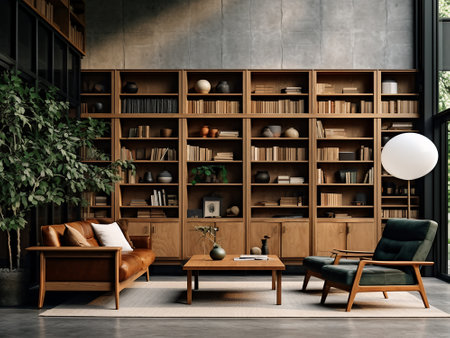Introduction to Natural Finishes
In recent years, natural finishes have become a defining feature in contemporary UK interior design. Embracing materials that highlight authenticity, texture, and warmth, British homeowners and designers are increasingly turning to organic elements to create inviting and timeless spaces. The popularity of natural finishes—ranging from untreated wood and stone to lime plaster and woven fibres—reflects a broader shift towards sustainability and wellbeing within the home environment. As urban lifestyles demand more comfort and tranquillity indoors, these finishes offer a tactile connection to nature, subtly blending traditional British craftsmanship with modern sensibilities. This growing trend is not only a response to environmental concerns but also an aesthetic choice that shapes the unique character of today’s UK interiors.
2. Popular Types of Natural Finishes
Natural finishes are making a strong comeback in contemporary UK interiors, not only for their aesthetic value but also for their sustainability and tactile qualities. In many British homes, there is a renewed appreciation for authentic materials that connect spaces with the outdoors and local heritage. The following table provides an overview of the most popular natural materials currently used across the UK:
| Material | Common Applications | Key Characteristics |
|---|---|---|
| Timber | Flooring, wall panelling, exposed beams, furniture | Warmth, versatility, natural grain patterns; commonly oak, ash, or reclaimed woods |
| Stone | Fireplaces, flooring, feature walls, kitchen worktops | Durability, timeless elegance; often uses local stones such as slate or limestone |
| Limewash | Wall and ceiling finishes in period and new-build properties alike | Soft matte texture, breathable surface, subtle colour variations; traditional yet modern appeal |
| Clay Plasters | Wall coverings in living rooms, bedrooms, and eco-homes | Tactile finish, regulates humidity, low environmental impact; available in earthy tones |
The Enduring Appeal of Timber and Stone
Timber remains a favourite due to its warmth and ability to age gracefully over time. Reclaimed wood is particularly sought-after in the UK for its sustainable credentials and unique character. Stone finishes—especially those sourced locally—bring a sense of permanence and regional identity to interiors. Limestone floors or Welsh slate hearths are both highly prized for their robustness and visual impact.
Limewash: A British Classic Revived
Limewash has seen a resurgence as homeowners seek alternatives to modern paints. Its soft finish and natural pigments complement period features while offering a breathable solution suited to the UKs often damp climate. This makes limewash ideal for cottages, barn conversions, and even contemporary extensions where authenticity meets innovation.
Clay Plasters: Sustainable & Stylish Choices
Increasingly specified in sustainable builds and eco-renovations, clay plasters provide both functional benefits and understated beauty. Their ability to regulate indoor humidity is particularly valued in Britain’s variable weather conditions. The gentle earth tones harmonise with other natural materials and support the calm, grounded atmosphere favoured in modern British interiors.

3. Current Trends in UK Interiors
Over recent years, natural finishes have taken centre stage in the evolution of modern British interiors. Across homes, offices, and public spaces throughout the UK, there is a clear shift towards embracing authenticity, sustainability, and tactile quality in design choices. This movement is driven not only by environmental considerations but also by a growing appreciation for materials that age gracefully and offer unique character to each space.
One of the most prominent trends is the use of exposed wood in both structural elements and decorative accents. From oak floorboards in period properties to reclaimed timber beams in urban lofts, wood is celebrated for its warmth and ability to soften otherwise minimalist environments. Limewashed walls and clay plasters are also seeing renewed interest, prized for their textured finish and ability to regulate indoor humidity—qualities that resonate with the UKs often damp climate.
Stone surfaces, particularly British limestone and slate, are increasingly used for kitchen worktops, fireplace surrounds, and bathroom tiles. These materials provide a subtle nod to traditional British architecture while fitting seamlessly into contemporary settings thanks to clean lines and understated colour palettes. In addition, polished concrete floors have moved from commercial projects into residential interiors, favoured for their durability and modern aesthetic.
The trend extends beyond materials to include natural colour schemes inspired by the British landscape—think muted greens, earthy browns, and soft greys. Soft furnishings in linen or wool complement these finishes, creating spaces that feel comfortable yet refined. Layering textures has become an essential styling technique: rough-hewn woods paired with smooth ceramics or matte metals deliver visual interest without overpowering the room’s overall calm.
Ultimately, natural finishes in contemporary UK interiors reflect a desire to create homes that are grounded and personal. There is an emphasis on craftsmanship, local sourcing, and designs that respect both heritage and innovation. By blending tradition with modern sensibilities, British designers are redefining luxury as something honest and enduring rather than merely opulent.
Sustainability and Local Sourcing
In recent years, the UK interior design landscape has witnessed a marked shift towards sustainability, with natural finishes playing a pivotal role in this transformation. Environmental considerations are now at the forefront of material selection, as both designers and homeowners increasingly seek ways to minimise their carbon footprint while supporting local industries. This conscious approach is not only about reducing environmental impact but also about celebrating British craftsmanship and heritage.
The Environmental Case for Natural Finishes
Natural finishes such as lime plaster, untreated timber, and stone are inherently low in volatile organic compounds (VOCs) and often require less energy-intensive processing compared to synthetic alternatives. Their durability and ease of maintenance further contribute to a lower lifecycle impact, aligning well with sustainable design principles.
Preference for British-Made Materials
A distinct trend is the preference for sourcing materials locally. Utilising British-made stone, timber from responsibly managed UK woodlands, and other regional resources minimises transportation emissions and supports rural economies. Additionally, local materials are typically more suited to the UK’s climate, ensuring longevity and reducing the need for frequent replacement.
Comparison of Material Sourcing Approaches
| Aspect | Imported Materials | British-Made/Eco-Friendly Materials |
|---|---|---|
| Carbon Footprint | High (due to long-distance transport) | Low (shorter supply chains) |
| Support for Local Economy | Limited | Strong |
| Adaptability to UK Climate | Variable | Optimised |
| Traceability & Certification | Difficult to verify | Easier to ensure ethical sourcing |
Eco-Certifications and Best Practices
The rise in demand for eco-friendly interiors has led to greater awareness of certifications such as FSC (Forest Stewardship Council) for timber or BES 6001 for responsibly sourced construction products. Designers now routinely seek suppliers who can demonstrate transparent supply chains, ethical labour practices, and a commitment to biodiversity preservation.
This growing emphasis on sustainability is not merely a passing trend; it reflects a broader cultural value within the UK towards stewardship of the environment. As clients become more informed, they are increasingly requesting interiors that tell a story of provenance, responsibility, and care for future generations.
5. Inspirational Case Studies
Showcasing Standout UK Projects
The application of natural finishes in contemporary UK interiors is best appreciated through real-life examples. Across the country, both residential and public spaces have embraced this movement, resulting in environments that are as inviting as they are sustainable. Below, we highlight a selection of notable projects that demonstrate how natural materials can be thoughtfully integrated into modern British design.
Residential Gems: The Cotswolds Stone Cottage
A beautifully restored stone cottage in the Cotswolds stands as an exemplary case of using local materials to enhance authenticity. Exposed limestone walls, reclaimed timber beams, and lime plaster finishes breathe new life into the historical building while maintaining its original character. Local interior designer Harriet Bell notes, “Clients increasingly value the tactile quality and subtle imperfections of natural finishes—they add a warmth you simply can’t replicate with synthetic alternatives.”
Urban Innovation: London Townhouse Transformation
In the heart of London, a Victorian terrace has been reimagined with sustainability in mind. The designers utilised British oak for flooring and bespoke cabinetry, paired with clay-based paints and wool textiles. Architect Thomas Glover comments, “We wanted every element to reflect both the heritage of the building and the priorities of today’s eco-conscious homeowners. Natural finishes were key to achieving this balance.”
Public Spaces: The Manchester Library Revamp
The recent refurbishment of Manchester Central Library demonstrates how natural finishes can elevate public environments. Here, terrazzo made from recycled aggregates complements restored hardwood panelling and sheep’s wool acoustic panels. Project lead Fiona McArthur says, “Using locally sourced and low-impact materials was central to our approach—it created a healthier space for the community while celebrating regional resources.”
Key Takeaways from Designers
Across these case studies, several recurring themes emerge: a deep appreciation for locally sourced materials; a desire to retain or echo historic features; and a commitment to environmental responsibility. As these projects illustrate, natural finishes are not merely a trend but are becoming integral to how interiors across the UK are conceived and crafted.
6. Practical Tips for Application
For homeowners and designers looking to embrace natural finishes within UK interiors, a practical approach is essential to ensure both aesthetic appeal and long-term performance. Here’s a concise guide to help navigate the selection, installation, and maintenance of these materials.
Choosing the Right Natural Finish
When selecting natural finishes such as timber, stone, or lime plaster, consider the building’s age, character, and existing palette. In period homes, reclaimed wood or traditional lime render can complement original features. For more contemporary settings, look for sustainably sourced oak flooring, slate tiles from British quarries, or innovative clay-based paints that offer both durability and subtle texture. Always verify provenance and sustainability credentials—FSC certification for wood is a must.
Installation Best Practices
Preparation
Proper preparation of surfaces is crucial. For instance, applying limewash on walls requires a breathable substrate; avoid modern plasters or paints that may trap moisture. With timber floors or panels, allow wood to acclimatise to the UK’s variable humidity before installation—this reduces warping and ensures a stable fit.
Professional Expertise
While some finishes like waxed wood floors or exposed brickwork can be tackled by capable DIYers, others benefit from skilled tradespeople familiar with traditional techniques—especially with lime plastering or stonework. Don’t hesitate to consult local specialists who understand British construction methods.
Maintenance in the UK Climate
The UK’s damp climate poses unique challenges. Opt for breathable sealants on wood and stone surfaces; this helps manage moisture levels and prevents issues like mould or rot. Regularly re-oil wooden worktops and reseal stone tiles in kitchens and bathrooms to maintain their resilience. For painted finishes such as mineral-based emulsions, gentle cleaning with soft cloths preserves both colour and texture without damaging the surface.
Sustainable Care Routines
Choose low-impact cleaning products wherever possible—avoid harsh chemicals that might degrade natural materials. Embrace periodic care as part of your home maintenance schedule: inspect for wear, address minor repairs promptly, and seek local advice when dealing with listed buildings or conservation areas.
Summary Guidance
The successful use of natural finishes in UK interiors relies on thoughtful selection matched to context, careful installation respecting traditional methods, and ongoing maintenance tailored to Britain’s environmental conditions. By following these practical tips, you’ll create spaces that not only look beautiful but also stand the test of time—a true celebration of nature within contemporary British living.
7. Conclusion: Looking Forward
Reflecting on the current landscape of natural finishes in contemporary UK interiors, it is clear that the movement towards sustainability, authenticity, and tactile beauty is more than a passing trend. Throughout this exploration, we have seen how UK homeowners and designers are increasingly prioritising materials such as timber, stone, clay plasters, and limewashes—not only for their visual appeal but also for their environmentally responsible credentials. The growing appreciation for craftsmanship and locally sourced materials echoes a broader cultural shift towards mindful consumption and heritage preservation. Looking ahead, we anticipate several key directions for natural finishes in UK interiors. Firstly, innovation in sustainable manufacturing processes will likely introduce new eco-friendly finishes that retain the character of traditional materials while improving durability and maintenance. Secondly, the integration of smart technologies may allow natural materials to perform better in modern homes—think breathable walls with improved insulation or timber treatments that extend lifespan without harmful chemicals. Lastly, the influence of British climate and architecture will continue to inspire unique applications of natural finishes, blending classic charm with contemporary sensibilities. In summary, as the UK’s design community continues to champion environmental stewardship and well-being through interior choices, natural finishes are poised to remain at the heart of inspiring and forward-thinking living spaces.


